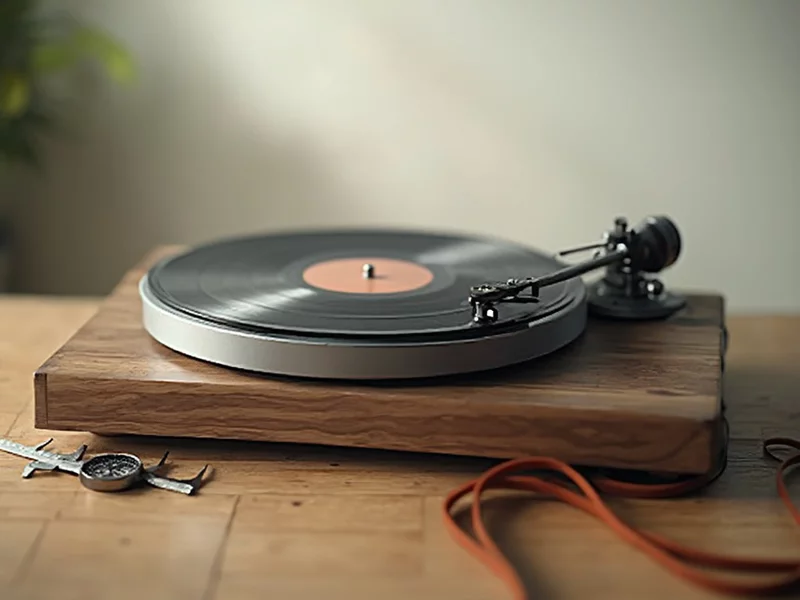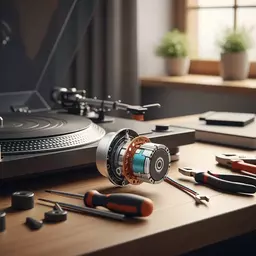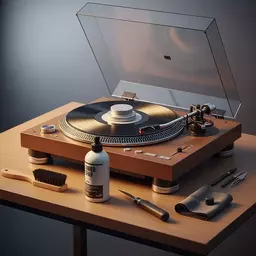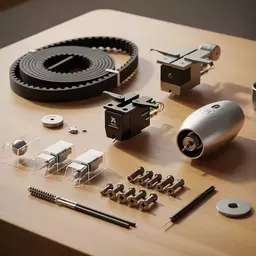Turntable Belt Sizes Made Simple

Understanding the intricacies of turntable belts is essential for every vinyl enthusiast. These seemingly simple components hold the key to your record's sound quality and longevity. Are you ready to explore how proper maintenance can elevate your listening experience?
What You Will Learn
- Turntable belts are crucial for maintaining consistent playback speed, impacting overall sound quality.
- The material and thickness of a belt can significantly affect its performance and durability.
- Regularly checking and replacing belts can prevent damage and improve the longevity of your turntable.
- Accurate measurement techniques for selecting the right belt ensure optimal energy transfer and sound fidelity.
- Routine maintenance, including cleaning and tension checks, is vital for preserving your turntable's performance.
Turntable Belt Essentials: Function, Performance, and Maintenance
This visual highlights the critical aspects of turntable belts, covering their function, impact on sound quality, and key maintenance practices.
Function: How Turntable Belts Work
Connects motor to platter, ensuring consistent rotation.
- Material: Rubber or PVC impacts performance.
- Thickness: Influences tension & speed.
- Length: Crucial for effective energy transfer.
Impact on Sound Quality & Performance
Integral for high-fidelity sound; worn belts cause issues.
- Improper Speed: Worn belt = too slow/fast.
- Vibration Issues: Loose/damaged belts introduce noise.
- Longevity: Regular replacement prevents damage.
Selecting the Right Turntable Belt
Precision in measurement ensures optimal playback.
- Measure sub-platter diameter for size.
- Note current belt's wear & tear.
- Understand material differences (rubber vs. others).
- Check compatibility with turntable model.
Future Maintenance Tips
Regular upkeep ensures longevity and optimal sound.
- Inspect belt for wear/stretching regularly.
- Clean platter & sub-platter area.
- Check belt tension occasionally.
- Replace belt every 1-3 years (usage dependent).
Understanding Turntable Belts and Their Importance in Record Playback
As a passionate audiophile, I can’t stress enough how crucial turntable belts are to the overall performance of your vinyl setup. They play a vital role in ensuring that your records spin at the right speed, leading to optimal sound quality. Without a properly functioning belt, even the most high-end turntable can falter, resulting in a disappointing listening experience. To learn more about the mechanics of turntables, you can refer to authoritative sources like Wikipedia's entry on turntables. So, let’s dive into the world of turntable belts!
Turntable belts are responsible for connecting the motor to the platter. They help maintain consistent speed during playback, which is essential for achieving that rich, warm sound we all crave. If you’ve ever noticed your records sounding a bit off, it might just be time to check your belt!
What Are Turntable Belts and How Do They Function?
At their core, turntable belts are flexible bands made from various materials, designed to drive the platter’s rotation. They wrap around the platter and the sub-platter, creating a direct connection with the motor. This connection allows the motor to transfer energy and maintain the platter's speed. Without a functioning belt, your vinyl records may not spin correctly, leading to speed issues and potential damage over time. The National Park Service provides interesting insights into the evolution of record players, highlighting the importance of every component.
- Material: Commonly made from rubber or PVC, each material can affect performance.
- Thickness: The thickness of the belt can influence the tension and thus the playback speed.
- Length: An appropriately sized belt is crucial for effective energy transfer from the motor.
Choosing the right belt means considering these factors carefully. If you’re unsure, my site, Turntable Repair Australia, has plenty of resources to help you find the best fit for your turntable!
The Role of Belts in Sound Quality and Turntable Performance
Belts are not just simple accessories; they are integral to achieving high-fidelity sound quality. When a belt is worn or stretched, it can lead to speed inconsistencies, resulting in pitch variations and distortion. This affects how music is reproduced, and for audiophiles, that can be a dealbreaker! For those looking to optimize their setup, exploring turntable belt upgrades can significantly enhance audio performance.
- Improper Speed: A worn belt can cause your records to play too slow or too fast.
- Vibration Issues: A loose or damaged belt may introduce unwanted vibrations.
- Overall Longevity: Regularly replacing belts can save your turntable from further damage.
By understanding the significance of your turntable belt, you can take proactive steps to maintain sound quality. As someone who has dedicated years to turntable repair, I’ve seen firsthand how a simple belt change can revive an old setup and bring your cherished records back to life!
Pro Tip
Did you know? Regularly checking and replacing your turntable belt can enhance the overall sound quality dramatically. A fresh belt ensures consistent speed, reducing pitch variations and distortion, allowing you to experience your vinyl records as they were meant to be heard!
Frequently Asked Questions About Turntable Belts
What is the main function of a turntable belt?
A turntable belt connects the motor to the platter, ensuring consistent rotation and proper playback speed, which is crucial for optimal sound quality.
How does a turntable belt impact sound quality?
A properly functioning belt ensures consistent speed, preventing pitch variations and distortion. A worn or stretched belt can lead to improper speed and unwanted vibrations, degrading sound quality.
What factors should I consider when selecting a new turntable belt?
When selecting a new belt, consider its material (e.g., rubber, PVC), thickness, and length. Accurate measurement of the sub-platter diameter is also crucial for ensuring effective energy transfer.
How often should I replace my turntable belt?
It's generally recommended to replace your turntable belt every 1-3 years, depending on usage. Regular inspection for signs of wear, stretching, or loss of tension can help determine the right time for replacement.
What maintenance tips can help prolong the life of my turntable belt?
Regular maintenance includes inspecting the belt for wear, cleaning the platter and sub-platter area to prevent dirt buildup, and occasionally checking the belt tension. These steps help ensure optimal performance and longevity.
Summarizing Key Points on Selecting the Right Turntable Belt
Choosing the right turntable belt is crucial for enjoying your favorite vinyl records in the best possible quality. It’s all about precision and understanding what your turntable needs. To recap, here are some important measurement techniques and considerations to keep in mind:
- Measure the sub-platter diameter accurately to find the correct belt size.
- Take note of any wear and tear on your current belt.
- Understand the material differences between rubber and other belt types.
- Be aware of compatibility issues with various turntable models.
Taking the time to ensure you have the right measurements will lead to a smoother playback experience and longer-lasting performance from your turntable. Trust me; your records will sound even better when everything is in perfect harmony!
Future Maintenance Tips to Ensure Optimal Turntable Performance
Once you've got the right belt installed, regular maintenance is key to keeping your turntable running smoothly. Here are some tips to keep in mind:
- Regularly inspect your belt for signs of wear or stretching.
- Clean the platter and sub-platter area to prevent dirt buildup.
- Occasionally check the tension of the belt to ensure it’s not too loose or tight.
- Consider replacing the belt every 1-3 years, depending on usage.
Don’t forget, a little upkeep goes a long way! By following these maintenance tips, you can ensure your turntable provides the rich analog sound you love. After all, who wouldn’t want to keep their vinyl spinning at its best? 😊
Encouragement to Engage and Explore Further
Join the Community of Vinyl Enthusiasts for More Tips
I invite you to dive deeper into the world of vinyl with us at Turntable Repair Australia! Whether you’re a beginner or a seasoned audiophile, there’s always something new to learn. Joining our community means you’ll have access to a wealth of knowledge and support from fellow music lovers. Plus, we share the latest tips and tricks to help you get the most from your turntable!
Share Your Experience and Recommendations on Turntable Belts
Your insights matter! I’d love to hear about your experiences with different turntable belts. Have you found a brand or type that works wonders for your setup? Sharing your recommendations not only helps others in our community but also creates a rich tapestry of knowledge that benefits us all. Let’s keep the conversation going—together we can preserve the beauty of analog sound!
Recap of Key Points
Here is a quick recap of the important points discussed in the article:
- Turntable belts are essential for maintaining the correct playback speed and sound quality.
- Consider material, thickness, and length when selecting a turntable belt for optimal performance.
- Regularly inspect and replace belts to avoid speed inconsistencies and ensure a smooth listening experience.
- Proper maintenance, including cleaning and tension checks, can prolong the life of your turntable.
Popular Posts
 Are you ready to elevate your turntable's performance? Understanding the nuances of motor replacemen
Are you ready to elevate your turntable's performance? Understanding the nuances of motor replacemen
 Have you ever wondered how a little maintenance can dramatically enhance your turntable's performanc
Have you ever wondered how a little maintenance can dramatically enhance your turntable's performanc
 Have you ever found yourself frustrated with a turntable that just won't play right? The good news i
Have you ever found yourself frustrated with a turntable that just won't play right? The good news i
 Have you ever considered how the condition of your tonearm affects the music you love? Proper tonear
Have you ever considered how the condition of your tonearm affects the music you love? Proper tonear
